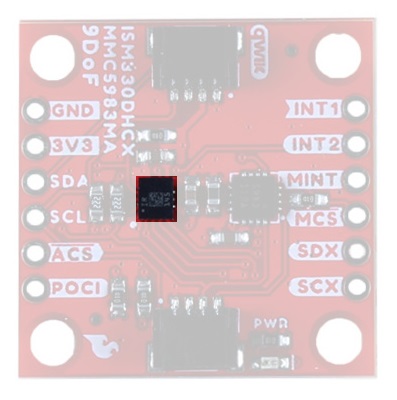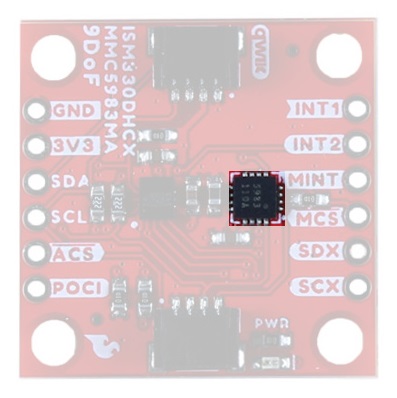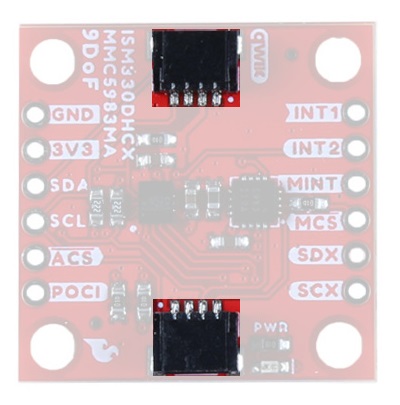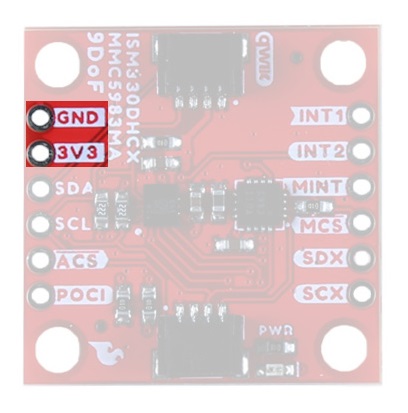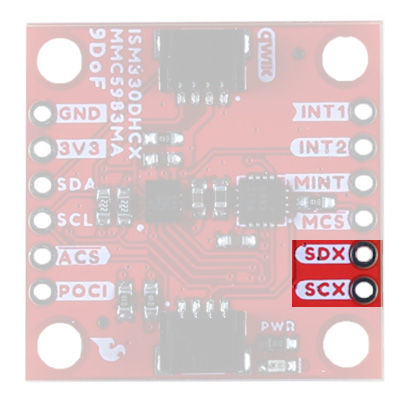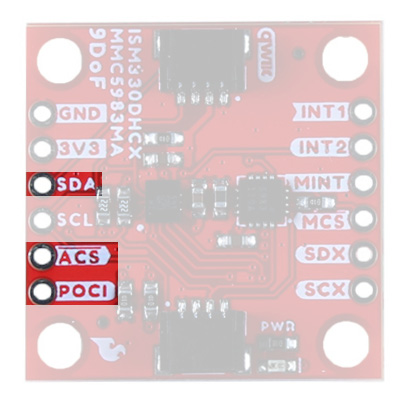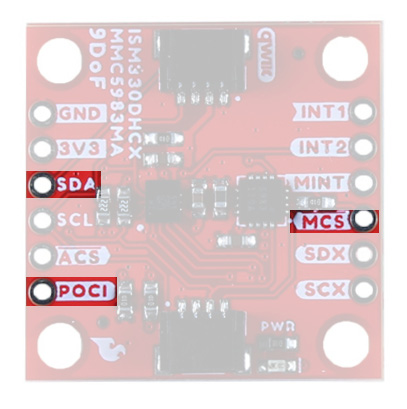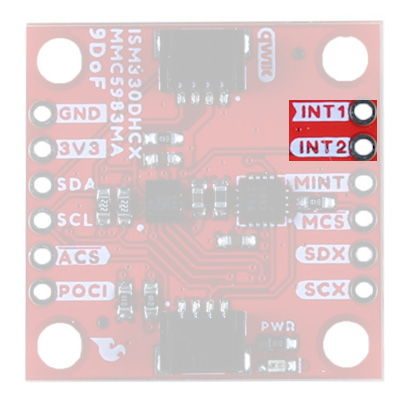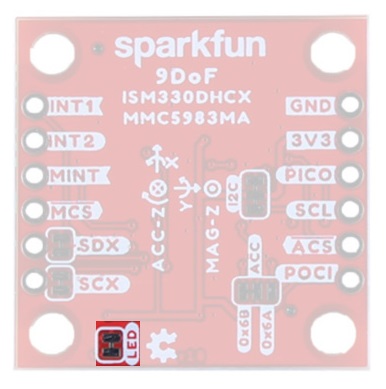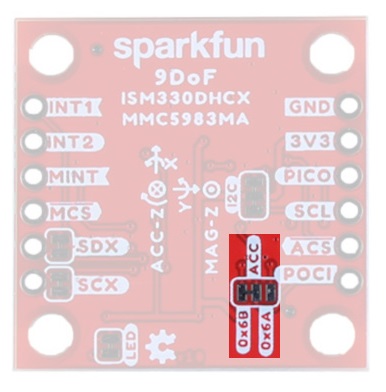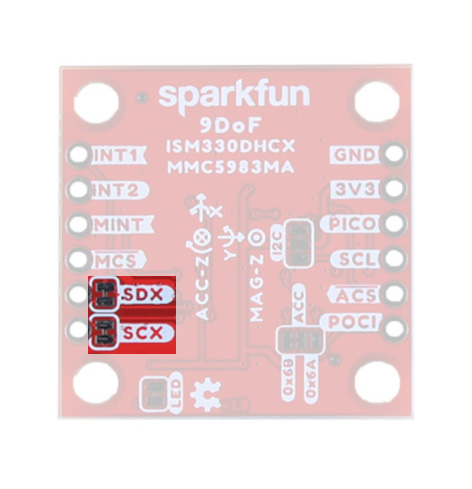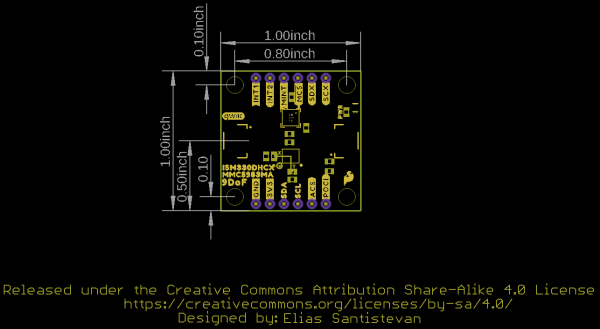Qwiic 9DoF - ISM330DHCX, MMC5983MA Hookup Guide
Hardware Overview
ISM330DHCX 6DoF
The ISM330DHCX is a small, system-in-package from STMicroelectronics featuring a high-performance 3D digital accelerometer and 3D digital gyroscope capable of wide bandwidth, ultra-low noise and a selectable full-scale range of ±2/±4/±8/±16 g. The 3D gyroscope has an angular rate range of ±125/±250/±500/±1000/±2000/±4000 dps and offers superior stability over temperature and time along with ultra-low noise.
The ISM330DHCX as implemented in the 9DoF can run in two different modes:
Mode 1
This is the default "peripheral only" mode. This mode allows you to use either I2C or SPI. By default, I2C is enabled with an address of 0x6B. By manipulating the associated jumper, you can change the I2C address to 0x6A (cut the power side and close the ground side) or switch to SPI mode (both jumpers open).
Mode 2
This mode enables a secondary I2C port that the 6DoF controls; up to 4 external sensors can be connected to the I2C controller interface of the device. External sensors communicate via the SCX and SDX (PICOX) lines - the SCX jumper will need to be opened.
MMC5983MA
The MMC5983MA is an AEC-Q100 qualified, fully integrated 3-axis magnetic sensor with on-chip signal processing and integrated I2C/SPI bus. It has superior dynamic range and accuracy with ±8G FSR, 18bit operation, 0.4mG total RMS noise, and can enable heading accuracy of 0.5º. More information can be found in the datasheet.

Qwiic Connectors
Our Qwiic Ecosystem makes sensors pretty much plug and play. There's a Qwiic connector on either side of the Qwiic 9DoF - ISM330DHCX, MMC5983MA breakout to provide power and I2C connectivity simultaneously. The default I2C address for the ISM330DHCX is 0x6B, and the I2C address for the MMC5983MA Magnetometer is 0x30.
Pins
Power
Ideally, power will be supplied via the Qwiic connectors, but we've also broken out plated through hole pins to supply 3.3V and Ground, should you prefer. Make sure to pay attention to logic levels - supply voltage to this board should range from 1.71 V to 3.6 V.
I2C
For flexibility, we've broken out the I2C functionality as seen below. Primary I2C pins are broken out to SDA and SCL:
Secondary I2C pins are broken out to SDX and SCX. These pins are used solely for Mode 2- Sensor Hub Mode - where the ISM330DHCX reads other sensors. You must cut the SDX and SCX jumpers on the back of the board in order to use this mode.
SPI
Like the I2C functionality, we've also broken out the SPI functionality to PTH pins.
SPI Pins for the ISM330DHCX are broken out to SDA, POCI, and the ACS (Accelerometer Chip Select) highlighted here:
SPI pins for the MMC5983MA are broken out to SDA, POCI, and the MCS (Magnetometer Chip Select) highlighted here:
Interrupt
Interrupt functionality for the 6DoF accelerometer is available via two PTH pins - INT1 and INT2. INT2 can be configured to an Input/Output pin and can be used to synchronize data for Sensor Hub Mode.
Interrupt functionality for the Magnetometer is available via the MINT pin.
Jumpers
LED
If power consumption is an issue, cutting this jumper will disable the Power LED on the front of the board.
I2C
Like our other Qwiic boards, the Qwiic Micro Magnetometer comes equipped with pull-up resistors on the clock and data pins. If you are daisy-chaining multiple Qwiic devices, you will want to cut this jumper; if multiple sensors are connected to the bus with the pull-up resistors enabled, the parallel equivalent resistance will create too strong of a pull-up for the bus to operate correctly. As a general rule of thumb, disable all but one pair of pull-up resistors if multiple devices are connected to the bus. To disable the pull up resistors, use an X-acto knife to cut the joint between the two jumper pads highlighted here.
I2C Address/SPI
By default, I2C is enabled with an address of 0x6B. By manipulating this jumper, you can change the I2C address to 0x6A (cut the power side and close the ground side) or switch to SPI mode (both jumpers open).
SCX/SDX
The SCX and SDX pins are specific to Mode 2 of the ISM330DHCX and are used for peripheral communication. By default they are closed - to use Mode 2 you will need to cut both traces to open the jumper.
Board Outline
Like many of our Qwiic Breakout Boards, the Qwiic 9DoF ISM330DHCX-MMC5983MA measures 1" x 1".
